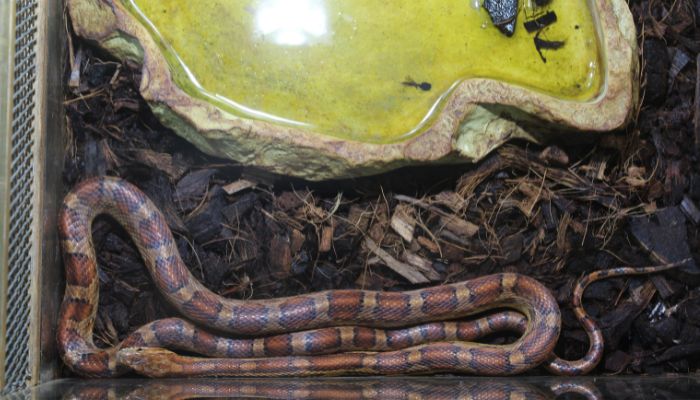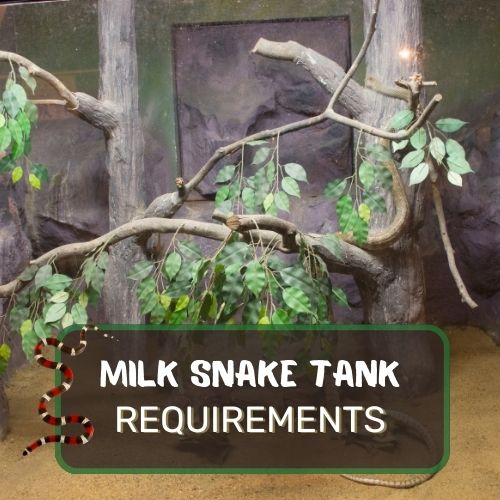Ever watched a milk snake and wondered, “Could it pull off a Spider-Man move and climb walls?” It’s not just a fun musing; understanding snake locomotion can unravel a world of insights into their behavior, anatomy, and survival tactics.
Yes, milk snakes can climb, especially rough or textured surfaces. However, they may struggle with smooth walls due to their scales needing grip. While not arboreal by nature, their climbing skills are decent, but not as adept as some tree-dwelling snake species.
In this deep dive, we’ll explore the fascinating world of snake movement, spotlighting milk snakes and their vertical capabilities.
From the basics of their slithering mechanics to the challenges they face when attempting to ascend, and even how to house them safely, get ready to discover the hidden acrobatics of these captivating reptiles!

Table of Contents
Snake Locomotion and Climbing: Understanding the Basics
So, you’ve seen a snake slithering around and wondered, “Can that thing climb a wall?” It’s a fascinating question, and when it comes to the lovely milk snake, you might be in for a surprise!
But before we jump into the acrobatics of our slithery friend, let’s break down some snake basics, shall we?
Different Types of Snake Movements
When you watch a snake slithering gracefully, it’s not just random wiggling – it’s art. It’s science. Each movement is tailored for a purpose, from chasing prey to evading predators. Here’s a closer look at the various types of snake movements:
- Lateral Undulation: This is your classic snake move. Like a sinuous wave, the snake propels itself forward using the curves of its body to push against surfaces. It’s fluid, rhythmic, and mesmerizing to watch.
- Concertina Movement: Picture a snake playing a game of stretch and anchor. It extends part of its body, grips down, and then pulls the rest of its body forward. It’s like watching an accordion in motion, and it’s particularly handy in tighter spaces where a full stretch might not be possible.
- Rectilinear Movement: Slow and steady wins the race. Here, the snake literally “crawls” using its belly scales. It’s a straight-line motion, almost caterpillar-like. The belly muscles contract in sequence, letting the snake inch forward in a slow, deliberate manner. Perfect for sneaky, stealthy approaches!
Each movement has its own advantages and is adapted to specific environments and scenarios. So, when you see a snake in action, remember: they’ve perfected the art of movement in their own slithering, graceful way.
How Vertical Movement Differs from Horizontal
Horizontal movement, like on the ground, uses the earth’s resistance. The snake can easily push off surfaces. But when it comes to vertical movement, like climbing walls? It’s a different ball game. It’s like asking us to walk versus climb a ladder.
The snake needs more than just the ground to push off from – it needs grip, strength, and often, a reason to ascend in the first place.
The Unique Structure of Their Scales
Now, this is where it gets juicy. Milk snakes, and snakes in general, have these special belly scales called “scutes.” Think of them as the snake’s climbing shoes. These scutes give them traction.
But, while they might help with climbing trees or rough surfaces, a completely smooth, vertical wall is still a daunting challenge for these reptiles.
How Their Body Weight Affects Their Ability to Climb
Imagine trying to climb a wall with a backpack filled with weights. It’s tough, right? Now, the milk snake doesn’t have a backpack, but its body length and weight play a crucial role in its climbing abilities.
The longer and heavier the snake, the harder it is to climb. Why? Because they need to support and move that weight upwards, against gravity.
In essence, while our milk snake friends have some impressive moves, climbing a completely smooth, vertical wall might not be their forte. But give them a tree, a textured surface, or a reason to ascend?
They’ll surprise you with their climbing prowess. So, next time you see a milk snake, give it a nod of respect. They’re more agile than they often get credit for!

Climbing Champions: Snakes That Ascend
When you think of climbers, mountain goats or monkeys might come to mind. But, snakes? Absolutely! There are several snake species that would give even the best climbers a run for their money.
Other Snake Species Known for Their Climbing Abilities
For instance, the Green Tree Python and the Boa Constrictor are known to spend a significant amount of their lives off the ground, nestled high in tree branches.
- Green Tree Python: A vibrant emerald climber, it’s perfectly adapted for life in the trees. With a prehensile tail and slender body, this python is an arboreal expert.
- Boa Constrictor: Larger than some, but an adept climber. Found often wrapped around tree branches, using its muscular body to navigate the treetops.
- Vine Snake: As the name suggests, it mimics vines, blending in perfectly as it slithers upwards.
- Corn Snake: Known to occasionally venture off the ground, especially when young, they’re comfortable both on land and in trees.
- Amazon Tree Boa: With its long, slender body, this boa is built for a life amongst leaves and branches, often surprising its prey from above.
Unique Adaptations That Assist in Climbing
Their secret? Unique adaptations. For one, they have a prehensile tail that acts like a fifth limb, helping them grip branches securely. Additionally, their bodies are streamlined and lightweight, ideal for ascending.
The way they wrap around branches, almost hugging them, showcases their superior muscle strength and control. These snakes are true climbers, having evolved specific features over millions of years that make vertical life second nature to them.

The Anatomy of a Climber: Milk Snake Body Examination
Let’s zero in on our star, the milk snake.
Detailed Look at the Milk Snake’s Body
Upon closer examination, the milk snake is a marvel. It has vibrant patterns which are not only captivating but also play a role in camouflage, especially when it’s winding its way up a tree or bush.
The scales are smooth, but underneath, there’s a powerhouse of muscles working in harmony, enabling it to move gracefully.
Features That Might Aid or Deter Climbing
But what makes the milk snake a potential climber? Well, like its climbing counterparts, it has specialized belly scales, or scutes, which provide traction. However, it doesn’t have the prehensile tail advantage that some tree-dwelling snakes boast.
This means while it can climb, it might find some terrains more challenging than others. Additionally, its body weight and length can either be an asset or a hindrance, depending on the situation.
In essence, while the milk snake has some climbing chops, it’s a bit of a mixed bag when pitted against the vertical champions of the snake world.

The Vertical Limits: Challenges Milk Snakes Face
Scaling walls, especially for a creature without limbs, is no small feat. It’s like asking us to crawl up a building using just our bellies! For milk snakes, climbing isn’t just about showcasing athletic prowess; it’s a matter of survival and adaptation.
But, even these agile reptiles have their vertical limits.
Surface Textures and Their Impact
Imagine trying to walk on an icy path in regular shoes. Slippery, right? Similarly, milk snakes struggle on overly smooth surfaces. Their scutes, while helpful, rely on some form of grip. A glassy surface? That’s a milk snake’s “ice patch”.
How Height and Incline Can Play a Role
Every ascent is an energy game. The steeper and taller the climb, the more energy it demands. While a small incline might be manageable, a near-vertical or overly tall structure could leave our snakey friend exhausted.
Possible Risks Associated with Climbing
Height doesn’t just mean a longer climb; it means a riskier descent. A fall from a significant height can be fatal. Plus, while up there, they could be exposed to predators like birds. Climbing, for all its advantages, comes with its share of dangers.
Differences between Rough and Smooth Surfaces
Rough surfaces, like tree barks or rocky terrains, are a milk snake’s playground. They offer multiple grip points, making the ascent relatively more manageable. Smooth surfaces, like polished walls or glass, pose a challenge.
The absence of grip points makes movement unpredictable.

Safe Housing for Captive Milk Snakes
If you’re considering becoming a proud milk snake parent or you already are one, their housing is paramount. These lovely reptiles aren’t just pets; they’re escape artists in the making!
To ensure their safety and your peace of mind, let’s dive into creating the perfect, secure home for them.
Importance of Secure Enclosures
Just like how we lock our doors at night, milk snakes need a secure enclosure. It’s not just to keep them in, but to keep potential threats out.
A well-secured environment ensures they stay safe from other pets, pests, and household hazards.
Tips for Preventing Escape Attempts
- Tight Lids: Ensure the top of the cage or terrarium fits snugly. A little gap is all a snake needs to make a break for it.
- Latch It Up: Consider cages with lockable latches. It adds an extra layer of security.
- Regular Checks: Routinely inspect the enclosure for any wear or gaps that might become potential exit points.
Accessories and Tools to Deter Climbing
While it’s natural for them to climb, you can manage their climbing endeavors. Place taller accessories near the center rather than the edges, so they can’t use them as a ladder to escape.
Smooth, vertical sides can deter climbing attempts, as can barriers like a lip at the top of the enclosure.
The Importance of Temperature and Humidity
Like any cold-blooded creature, milk snakes rely on external conditions to regulate their body temperature. Ensuring the right temperature and humidity levels isn’t just about comfort; it’s about health.
Proper conditions will reduce stress, making them less likely to try and escape. Moreover, it ensures they remain active, hydrated, and in tip-top shape.
Creating the perfect home for a captive milk snake is an art and science combo. A happy snake is a content snake, less likely to explore escape routes and more likely to thrive. So, prioritize their comfort, and you’ll both enjoy the bonding experience!
Summary
You’ve journeyed through the world of milk snakes and their climbing abilities. From understanding the intricacies of snake locomotion to ensuring the safety of captive snakes, you now have a clearer picture of these fascinating creatures.
Remember, every snake is unique, showcasing nature’s versatility. As you continue exploring the realm of reptiles, let this knowledge guide and inspire you. Embrace the wonder of the natural world, and always keep learning!
FAQ
What surfaces can snakes not climb?
Snakes, including milk snakes, generally struggle with overly smooth surfaces. Think glass or polished metal. These provide little to no grip for their belly scales, making it hard for them to ascend.
How high can a snake climb?
The climbing height varies depending on the snake species and the surface. However, many snakes, if given the right environment like trees or rough walls, can climb several feet. Some arboreal species might even venture higher into tree canopies!
Can snakes get into the ceiling?
Yes, they can, especially if there are openings or vents. Snakes are curious and excellent at exploiting small gaps to explore new areas. Always ensure gaps, vents, and chimneys are securely covered if you’re trying to prevent a snake visit.
Can snakes move on slippery surfaces?
Snakes have a challenging time on slippery surfaces. Their movement relies heavily on friction. On a slick surface, they would flounder much like a car on ice. While they might be able to move a bit, efficient or directed movement becomes a task.




0 Comments